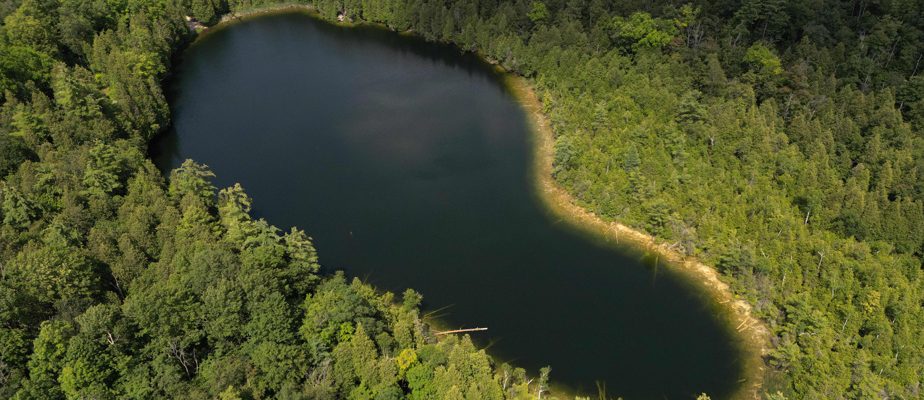(Milton) Visibly it is a tiny lake like there are thousands in Canada. But what lies beneath the surface makes it extraordinary: the exceptional preservation of its geological layers makes it the new world reference for the Anthropocene.
For years, geologists have sought to establish the place in the world (called the “golden nail”) that constitutes the best benchmark for this proposed new geological epoch, synonymous with the considerable impact of human activity on the planet.
And this place is therefore a small lake in the Canadian province of Ontario, a large suburb of Toronto, the country’s main city, the Anthropocene working group, set up by the International Commission on Stratigraphy, announced on Tuesday. (ICS).
Local legend claims that this lake has no bottom. However, its depth is on the contrary of an unequaled richness: the sediments show, more than anywhere else on Earth, that man has transformed the planet at all levels. And this includes at the geological level, in the physical composition of the earth.
“The lake is very deep, but it is not very big. This means that the waters do not mix to the bottom and therefore the sediments that accumulate are not disturbed”, explains Francine McCarthy of Brock University, met in April when the last samples were taken for the choice golden nail.

PHOTO PETER POWER, FRANCE PRESS AGENCY
Francine McCarthy of Brock University
Coal, oil
For centuries, Lake Crawford has quietly absorbed signs of change from the outside world. Everything that floats on the surface ends up in the depths of the lake.
The first people to leave their mark on the lake are Iroquois villagers who built houses on the banks in the 15th century. Subsequently, the sediments show the growing influence of Europeans on the landscape (cutting down of trees, new species, etc.).

PHOTO PETER POWER, FRANCE PRESS AGENCY
For centuries, Lake Crawford has quietly absorbed signs of change from the outside world. Everything that floats on the surface ends up in the depths of the lake.
Then in the 20th century, it was the turn of black ashes – resulting from the combustion of coal and oil – to accumulate in the lake in this region where cities developed and industrialized. Heavy metals such as copper and lead are also gradually appearing in the mud.
“We can observe local disturbances, regional events, such as pollution,” confirms Paul Hamilton, researcher at the Canadian Museum of Natural History. And the sediments “also document changes at the global level, in other words the atmospheric fallout of chemicals”.
“Each year has its own personality, a bit like the people,” raves Francine McCarthy, showing the annual lines of the geological “core” extracted from the lake.
These samples serve as markers, their extraction requires dexterity, precision and speed.
Tim Patterson, a researcher at Carleton University in Ottawa, and his team are specialists in this field. To recover without damaging the layers of sediment from the depths of the lake, they are busy filling large metal tubes with dry ice and alcohol.

PHOTO PETER POWER, FRANCE PRESS AGENCY
Tim Patterson, researcher at Carleton University
On these long icy sticks nearly two meters and 15 centimeters wide, which are submerged at the bottom of the lake for half an hour, the sediments stick together to form a succession of very distinct lines for each year, like tree rings. ‘a tree.
Great acceleration
During the April samples, it was the traces of plutonium that particularly interested Tim Patterson.
The beginning of the Anthropocene was indeed proposed in 1950 “to highlight something quite unique in world history: nuclear testing”, he explains.
“Humans had never done this before. And it leaves an imprint, not just regionally, but globally,” adds the researcher.
And the middle of the 20th century would also mark this pivotal moment when everything got carried away, when humanity entered a phase of great acceleration (consumption, production, pollution, etc.).

PHOTO PETER POWER, FRANCE PRESS AGENCY
These samples serve as markers, their extraction requires dexterity, precision and speed.
“For 12,000 years things went the same way. And then suddenly, very suddenly, everything changed. Today, the Earth has been sufficiently modified by human activities to behave differently,” notes Francine McCarthy, who has worked on the site since 1984.
The official endorsement by the world’s geological authorities that the Earth has exited the Holocene, the period that began around 12,000 years ago at the end of the last ice age, to enter the Anthropocene, the “epoch of ‘Human’, still remains uncertain.
But this enthusiast remains hopeful: “If geologists, who are the ones who discovered plutonium and oil in the rocks, accept that there is a fundamental change due to man, then perhaps measures will be taken “.
